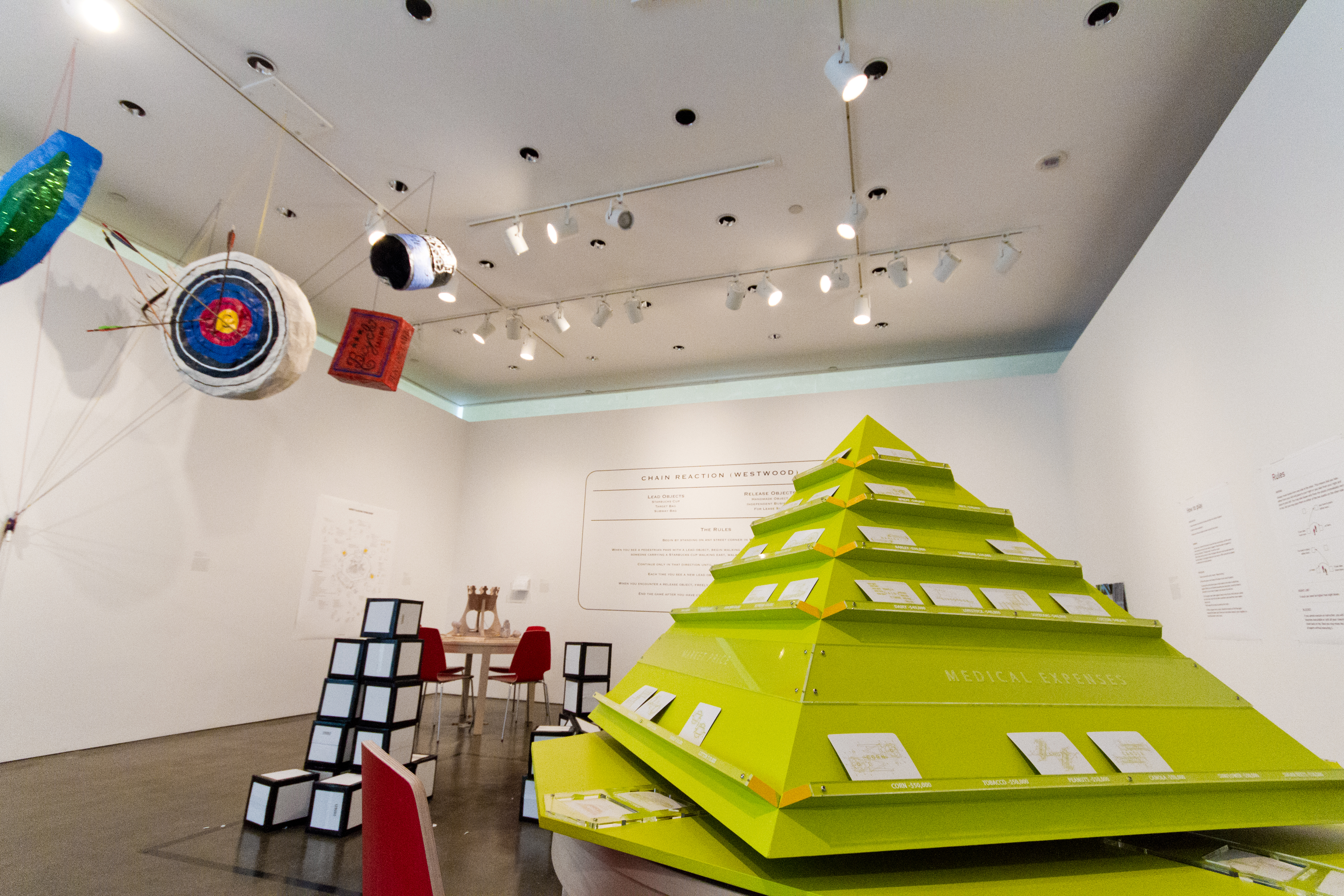“Game Room” exhibit at Hammer Museum encourages interaction

“Game Room” is a new exhibit at the Hammer Museum that redefines game design and art by letting visitors interact with the pieces.
By Sebastian Torrelio
Dec. 3, 2012 12:59 a.m.
Extravagantly designed piñatas dangle from above, the floor is littered with hollow boxes being procedurally stacked, and several guests furiously play a card game around a large bright green pyramid. All together, it makes for an unusual sight at an art museum.
Yet this kind of interaction is essential to visitors of “Game Room,” a new, free and engaging exhibition within the lobby of the Hammer Museum. The display, which opened Saturday, features six main portrayals of aesthetic play where the guest is invited to participate hands-on.
Each piece within “Game Room” redefines the idea of game design and artistic purpose by letting visitors escape boundaries, whether personally, with a deck of reimagined playing cards, or outwardly, with a navigational game that guests can play while walking through Westwood.
“It’s an opportunity to explore in a new context,” said UCLA alumna Allison Agsten, Curator of Public Engagement at the Hammer Museum and head of organization of “Game Room.” “Most institutions want to look outside their walls, but it’s hard to make that extension.”
Set within a glass-doored portion of the museum lobby, “Game Room” presents an open and inviting feel to guests entering the museum. Agsten said she enjoys how the portrayal gives them a permeable first experience separate from the bulk of traditional art exhibits.
“It is the most democratic space in the museum,” Agsten said. “That the public can come in and see the piece is very meaningful for me “¦ you can come and play and you don’t have to pay.”
Eddo Stern, a Design | Media Arts associate professor and director of the UCLA Game Lab, contributed one of his own installations to the exhibition. He said the meaning of the project is truly shown within the interactivity of each piece of art.
“If you’re showing games as art because they involve usable objects and interaction, they run at odds with more traditional interactions at a museum,” Stern said. “They force a redefinition of museums and these objects.”
Stern’s piece, titled “Moneymakingworkshop,” is a two- to four-player game where players compete in different roles over a set of 13 rounds by making “gold” in the form of paper ingots, coins and nuggets, contrasting fairness with the game’s rules to win. He said he hopes for the unbalanced and asymmetrical exhibit to appeal to guests through the exploration of tension and breaking of artistic conventions.
“A lot of my games involve a certain level of abuse and oppression of the players,” Stern said. “They acknowledge fun and what it means. Almost all my games involve physicality and (self-reflection).”
Stern’s sculptured composition compels the use of repetitive actions and immersive power struggles to give the guest a non-mediated experience in physical gaming through human-to-human contact.
However, not all the pieces featured in the exhibition are as formally engaging as his. One artist in “Game Room,” Sarah Bay Williams, plays with aesthetics and guest behavior in her installment, “Piñatas: Recreational Items from Unfortunate Events.”
“I got involved with the project because (Agsten) saw my piñatas elsewhere,” Williams said. “I made the piñatas for a friend “¦ and she decided to include it because it’s a multiplayer game that everyone can enjoy.”
Williams’ display is presented with five large piñatas hung from the ceiling of the exhibition, ranging from a board of arrows to a sailboat. It reflects on the art experience with a traditionally interactive piece set within the hands-off bounds of a museum.
“(The piñatas are) all connected to stories that I found about unfortunate happenings,” Williams said. “For instance, the sailboat is representative of a horrible race that happened in 1980 “¦ I was just thinking about the idea of games and piñatas and this is a way to smack and smash the unfortunate part of life and all the goodness in life tumbles forth.”
Her piece will emphasize this representation when the piñatas are destroyed on February 17, the last day of the display. Several toys and games from inside will then be available for guests to take.
By balancing a traditional sense of gaming with a break in artistic conventions, “Game Room” puts value on the cultural works of the Hammer Museum with each individual artist’s blend of imaginative public engagement.
“The Hammer specifically has put a lot of energy into creating culture on many different levels of access,” Stern said. “I think the show is very open and inviting to people who aren’t used to going to museums. It is more playful, more open, and helps to open context to what art can be.”
Email Torrelio at [email protected].


